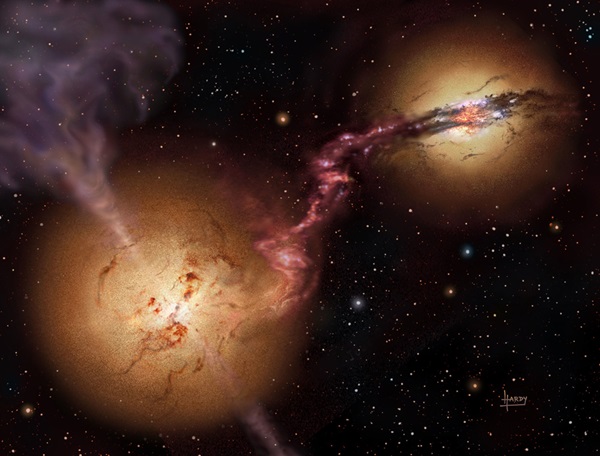Key Takeaways:
New observations made with the Submillimeter Array (SMA) of telescopes in Hawaii suggest that black holes — thought to exist in many, if not all, galaxies — were common even in the early universe, when galaxies were just forming. Astronomers have found two very different galaxies in the distant universe, both with colossal black holes at their heart, involved in a spectacular collision.
4C60.07 — the first of the galaxies to be discovered — came to astronomers’ attention because of its bright radio emission. This radio signature is one telltale sign of a quasar — a black hole, spinning rapidly, feeding on its parent galaxy. A new image captures the moment, approximately 12 billion years ago, when this galaxy ripped a stream of dusty gas from a neighbor.
When astronomers first studied 4C60.07, they thought that gas surrounding its black hole was undergoing a burst of star formation, turning virgin gas into stars at a remarkable rate — the equivalent of 5,000 of our Suns every year. The pressure of infrared glow from smoky debris in which the largest stars rapidly die revealed this prodigious activity.
The latest research, exploiting the keen vision possible with the SMA, revealed a surprise: 4C60.07 is not forming stars after all. Indeed, its stars may be relatively old and quiescent. Instead, the prodigious star formation is taking place in a previously unknown companion galaxy that is rich in gas and deeply enshrouded in dust, and has another colossal black hole glowing as its center.
“This new image reveals two galaxies where we only expected to find one,” said Professor Rob Ivison at the Science and Technology Facilities Council’s United Kingdom Astronomy Technology Center in Edinburgh, lead author of the study that will be published in the Monthly Notices of the Royal Astronomical Society. “Remarkably, both galaxies contain super-massive black holes, each capable of powering a billion, billion, billion light bulbs. The implications are wide-reaching: You can’t help wondering how many other colossal black holes may be lurking unseen in the distant universe.”
“It seems we were led to pluck the radio galaxy and its neighbor from the countless millions of objects in the sky because they are involved in a rare collision.”
Due to the finite speed of light, we see the two galaxies as they collided in the distant past, less than 2 billion years after the Big Bang. By now the galaxies will have merged to create a football-shaped elliptical galaxy. Their black holes are likely to have merged to form a single large black hole.
“The superb resolution of the SMA was key to our discovery,” said Steve Willner of the Harvard-Smithsonian Center for Astrophysics, a co-author of the paper. “These two galaxies are fraternal twins. Both are about the size of the Milky Way, but each one is unique.”
Dr. Glenn Morrison, an astronomer at the Institute for Astronomy and the Canada-France-Hawaii Telescope in Hawaii, added, “Understanding the prevalence of black holes in the early years of the universe will rely on combining information from across the whole electromagnetic spectrum.”










